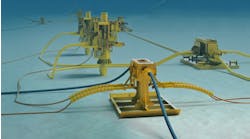Offshore staff
LONDON – Premier Oil has awarded most major front-end engineering and design contracts for its Tolmount gas development in the UK southern North Sea.
Wood Group is responsible for the offshore FEED, with Land & Marine handling the program for the beach crossing and Costain the onshore FEED.
In addition, Premier has signed a commercial heads of terms with the operator of the Dimlington terminal on the English east coast to process the Tolmount fluids and to undertake terminal modification works.
Following FEED and tendering of the major project scopes, Premier aims for development sanction during the first half of 2018.
At the same time subsurface studies are progressing on Tolmount East and Tolmount Far East ahead of any future appraisal drilling.
Last month, the Babbage field gas platform in the same sector became a Not Permanently Attended Installation, averaging 3,200 boe/d following a successful well intervention program.
Premier has started planning for the Cobra appraisal well in 2018, adjacent to Babbage: in parallel, the company will look to farm down some of its 50% interest.
Commissioning continues of theFPSO for Premier’s Catcher oil project in the UK central North Sea and will continue until sail-away from the Far East yard.
To date 10 development wells have been drilled - seven producers and three injectors - and a short subsea campaign is due to start in June to tie in the four recently completed Varadero wells.
Following positive drilling results, the company is hopeful of a higher plateau production rate and is reviewing the potential additional production capacity available from the FPSO.
West of Shetland, production from theSolan field during 1Q averaged 7,300 boe/d, lower than anticipated. This was due to the need to shut in the first (P1) production well following the failure of its electric submersible pump (ESP).
The well was subsequently reinstated on free flow with the intention of conducting a workover this summer in order to install two ESPs in the well. However, the improved performance from P1 has rendered this action unnecessary for the time being.
05/16/2017


